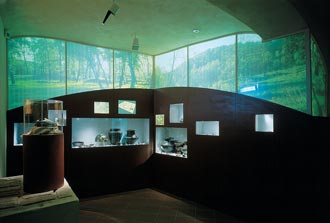Permanent Display 2. Before Zagreb
 The urbanisation of the area of the city, which has been going on for millennia, has erased many of the traces of the earlier periods.
The urbanisation of the area of the city, which has been going on for millennia, has erased many of the traces of the earlier periods.
Thanks to advances in the sciences of geology, anthropology and archaeology in Europe during the 19th century, the timetable of prehistoric and historic events has been elucidated. The end of the nineteenth and the beginning of the twentieth century was the period in which the science of archaeology was established, according to the divisions that are still recognised in the profession today. Many archaeological sites were discovered and there were frequent accidental finds of various kinds of archaeological material in the area of the city. The most important of these are Šćitarjevo (at the beginning of the 1880s), Donji Stenjevac (1896), Velika Gorica (1908), Kruge (1911) and Horvati (1912). Particular attention was excited by the discovery of a Roman necropolis in Savska ulica (1939) and an early medieval grave below Susedgrad (1940). Even after World War II a number of new finds were made and explored. The most important were the discovery of Bronze Age remains in Dežmanov prolaz (1949) and Ivanec Bistranjski (1955), the excavations at Ribnjak (1951), the explorations of a prehistoric grave area in Vrapče (1955), the Roman necropolis in Držićeva ulica (1959) as well as the systematic exploration of the Roman municipium af Andautonia in Šćitarjevo (1969).
The last two decades of the 20th century have marked a new period in the archaeological exploration of Zagreb and environs. Accidental discoveries made during building works are the best indicators of how much information about our past can still be obtained from the very centre of the city.

The archaeological map allows us to acquaint visitors with the most important finds and sites in the city and its region, their cultural and temporal features and the place where the finds are kept. Through it, we would like to draw attention once again to the importance and significance of today’s urban area in the most ancient past, to the exceptional value of the archaeological material that has been found, and to the thousands of years of culture that we have inherited.
Želimir Škoberne, Boris Mašić
 Princely tumulus in the Žumberak region
Princely tumulus in the Žumberak region
The village of Budinjak is located in the central section of Žumberak Mountains. Its height is 740 meters above sea level, near the most elevated point on the road through these heights linking Zagreb with the towns of Ozalj and Karlovac. Soon after starting to survey this plateau (Budinjačko polje od Budinjak Plain), we discovered a large cemetary of grave mounds or tumuli, with a hillfort settlement directly above it. The tumulus cemetery is located below the hillfort on the plateau to the north. Geodesic mapping revealed 141 tumuli. The tumuli are circular and of various sizes, with diameters from 5 to 20 meters and heights from 50 cm to 2.2 meters. The grave goods found at the Budinjak cemetery belong to the early Iron Age. The present state of research allows the cemetery to be assigned chronologically to the period from the 10th century to in the 6th century BC. In the summer of 1993, princely tumulus 3 was excavated in Budinjak Plain. It contained 10 graves, one with a bowl-shaped helmet. Thanks to such a valuable discovery, in the autumn of 1993, the excavation of tumulus 139 began. The tumulus was located on the northwestern edge of the burial mound cemetary. The diameter measured 19 meters, with a height od 2 meters. The tumulus contained seven burials. When tumulus 139 is considered in entirety, it can be concluded that it contained one double grave – princely grave 6 (male and female), and another six graves, three of which were female (graves 3, 5, and 7), and three male (graves 1, 4, and possibly 2). In terms of absolute chronology, all the burials in the tumulus can be dated to the 8th and the beginning of the 7th centuries BC. The scientific investigation of the bowl-shaped helmets from the princely warrior graves in tumulus 139 and tumulus 3 has enabled insight into the very complicated technique of manufacturing such helmets, which has further offered new possibilities of the classification and more precise dating of this group of the earliest Hallstatt period helmets.
Želimir Škoberne

